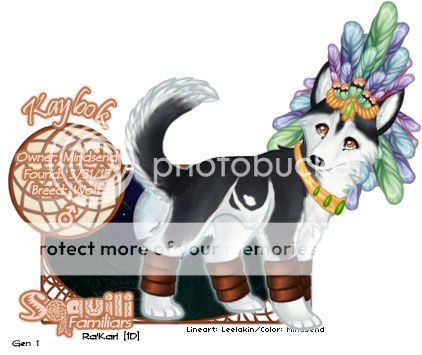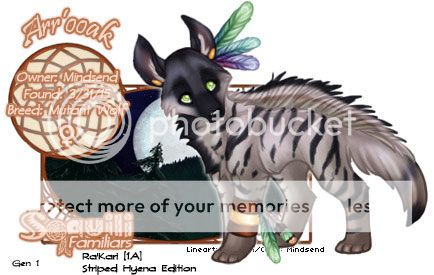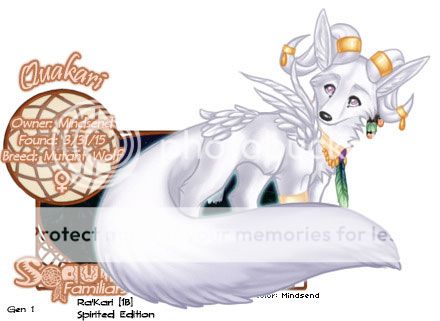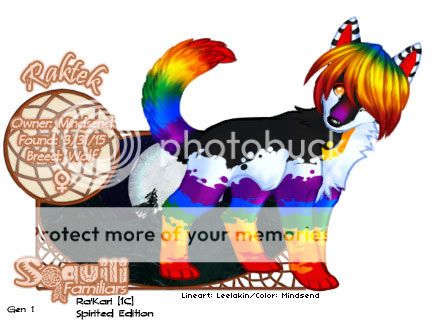|
|
|
|
|
|
|
|
|
 Posted: Tue Feb 09, 2016 7:35 pm Posted: Tue Feb 09, 2016 7:35 pm
Quote: ATTENTION!This thread has been moved. Please post your decorated wolfs in the new location for certs! ]http://www.gaiaonline.com/guilds/viewtopic.php?page=2&t=24895245#375960833 Ra'kari Wolf Tribe Caution: While it wont happen for a Long time, as there are only 20 wolves on the island, and only five of them are male, eventually there will some inbreeding involved. In addition, these wolves can, have, and will hunt sentient beings on occasion, despite not being evil, to keep balance on the island or in order to survive. If either of these facts trouble you, please do not go any further. Breedings: Currently Closed!Who can currently breed: None Method allowed: N/A Cut off number: N/A Note: Due to their numbers compared to the goats, and their size, in order to keep from straining the environment the wolves are currently limiting their breeding's -- if they get smaller pups in future generations that don't such big game, they might eventually have their limits added to how many can exist before needing the occasional bigger kill. They will, even if the goats don't explode in population, occasionally breed to try and keep from going extinct, but those are in small, singular batches at specific intervals.
|
 |
 |
|
|
|
|
|
|
|
|
|
|
|
|
 Posted: Tue Feb 09, 2016 8:15 pm Posted: Tue Feb 09, 2016 8:15 pm
 Basics BasicsSeeing themselves as the caretakers of the island, having been here for as long as their oral history can remember, the Ra'kari are a spiritual group of hunters and catchers, living off the land and, occasionally, capturing wild feral minded animals such as Peccary, Capybara, and Ocellated Turkey to fatten and lessen their impact on the environment. They also collect the eggs of the Giant tortoises of the land, monitoring the population raising the hatchlings up to later release once big enough that the other native predators cannot hunt them, only ever killing enough to keep the balance and allow them to create bowls from their uniquely shaped shells. However, as guardians of the land, they cannot play favorites -- when some of the other familiar populations get too high, the wolves of Ra'kari hunt. After a three years of near peace, having only picked off a single goat per season as they managed the populations of other animals, the wolves turned on the goats of Yahn Weya, having had a booming few years in population and descended onto the land to strip of the resources necessary to support such large numbers, and began picking off entire parties of gatherers that went beyond the traditional territory of the goats, stealing their seeds and scattering them into the earth. Enraged and emboldened by their numbers, wishing to rid themselves of the wolves permanently, the Yahn Weya took to the high mountains in force, leaving only some of their numbers behind, and descended upon the wolves from above in their own dens, catching them off guard and giving them no chance for rest, the tired members of the Yahn Weya retreating to the cliffs to rest as fresh warriors lowered to take their place. Desperate, the wolves howled for backup. And the parrots of Hawiya Ayelasdi came to their aid, the flock swarming at the eyes of attacking goats on the ground and swarming goats on the cliffsides until they fell to death or grave injury. Rallied, the remaining wolves fought valiantly until there were no more assailants, parrots and wolves giving up their lives to give others a chance to survive. It was only after every goat that had turned on them was dead and the heat of combat dimmed that they realized in horror what had happened: Not only had they lost all but twenty of their own members, only five males left in the whole pack, but they had decimated most of the goat herd that was the only prey animal large enough to be capable of allowing the wolves themselves to flourish. Setting into action, they began to dry and cure meats to store, hiding their males away in the heart of their territory, away from the cliffs, and now wait, watching the surviving members of the Yahn Weya, hoping to, eventually, be sure of their own survival. The island needs them. Even if those who live on it do not want them.
|
 |
 |
|
|
|
|
|
|
|
|
|
|
|
|
|
|
|
 Posted: Tue Feb 09, 2016 9:06 pm Posted: Tue Feb 09, 2016 9:06 pm
The Breeding Experiment Rules
The Main GoalStarting off with twenty Wolves, five males and Fifteen females, the goal is to see at what point it is impossible to avoid pairing up with a cousin while still being active reproductively. After which, the goal is to see how separated we can keep them even with similar relatives. Rules
The First Five males can only breed with the first gen females and the second gen females they are not related to.
The first Fifteen females can only breed with the first Five males and second gen males they are not related to
Third gen and beyond are limited to gen Two, Three and Four.
Exclusive pairings are not allowed at the current time: Try to create as many different 'lines' as possible. Romantically loyal but physically open pairs are allowed.
Try to avoid pairing up with cousins until there are no other options available, but focus on unrelated members within the three generations (One above, your own, one below) to keep them in the same general range of ages rather than going back to the low numbered generations with the cleaner bloodlines. THIS IS IMPORTANT!!
Currently, No lifemating/lovemating with a different species is allowed: Wolves only!
The first five males will not be able to breed until after the goats have reached 30 members to their tribe*, and will have a breeding actively purchased for every 10 goats after that. They will not actively try to hunt the goats** until the goats have gone over 100 members.
* (The Yahn Weya are currently Currently at 10 members, and the first two gen 1 breedings will put them at 20).
** Goats will not be successfully hunted unless an owner wishes to take the goat out of the breeding pool and kills the character in a hunt. in breedings with less than the maximum, the 'missing' children will have been hunted before they reached breeding age.
Higher Numbered Generations should have breeding priority. For example a Gen 5 pairing would be more important for the actual experiment than breeding their Gen 3 Grandparent.
If you own a wolf with all five of the original males as ancestors, try to find the LEAST related wolves you can within your generational limitations -- ones with first gen female ancestors that you have no blood relation to. Continue to look for the most distantly related until you have a wolf related to every one of the first fifteen females. At which point you report in what generation they are and try to find Third or More cousins to pair with. Report if you cannot.
I cannot stop you from breeding these wolves Non-Canonly in mixers on occasion. Just keep in mind that any breedings with Mainlanders/any wolves not originating from these twenty will NOT be in Island canon, but instead are 'doppleganger breedings' set on the main land with the other wolf, and should hopefully only be done on rare occasions. THANKFULLY, Familiars do not have a limited amount of breeding slots so this will not hurt the project beyond your breeding cooldown.
Wishing stars entered can only canonly be for a chance for familiars, as we cannot introduce new soquili to the island. If a familiar not native to the island or is of a restricted/banned breed, it cannot be used canonly on the island -- they can still be 'painted' by the spirits to the wish, but wont ever meet the character since they're far away. Wishing for parents/siblings etc in wishing stars will result in dopplegangers of their deceased relatives mainland.
|
 |
 |
|
|
|
|
|
|
|
|
|
|
|
|
 Posted: Wed Feb 10, 2016 9:53 am Posted: Wed Feb 10, 2016 9:53 am
FAQQ: Will the Ra'kari Wolves Hunt soquili? A: for the time being, no: Soquili breed at a much slower rate with smaller 'litters', and when they reach adulthood become far too large, and tend to be too unified, for the Ra'kari wolves to hunt. In addition, soquili grazing habits causes less harm than that of goats. Because of this, the Ra'kari are more prone to help the soquili learn how to leave a lighter impact and help manage the island's balance after they have developed a larger territory. This will not happen until the fourth generation a minimum. Q: Do they capture goat/Lizard familiars and fatten them like they do the capybara, turkeys, and peccary? A: With Familiars, they believe it is disrespectful to them to treat them that way and not let them live their lives naturally and unaware that their fate ends in the belly of a wolf. The Non spirit touched animals meanwhile are given comfortable lives within their main camp before slaughter, and some are raised through several generations before they add fresh blood from the wild into their stock. Q: How much do they hunt currently and how much do they raise? A: At their current size, the animals they raise and fish from the river near their home is enough to sustain them, however they still hunt wild game and some of the other familiar species to help keep their numbers under check as the largest predator of the island. Once the goats raise up in population, they will return to helping keep the numbers in check. Q: Armor? Tools? Soup? HOW DO THEY DO THIS? A: While wolves paws are not as dexterous as even a cats, much less a raccoon or hippogryph, they are still able to use them to manipulate things. Because of this they are able to make rough tools and accessories. Some Metal, such as Bronze, is beyond their abilities (though gold, Silver, and copper may be used, but is scarce enough to be used more as an accent or thin coating -- most gold items owned are leftovers from back before a time remembered, passed down heirlooms, scavenged from old ruined areas as gifts from "long ones" (a long dead human civilization, called such due to how long their arm and leg bones are and their size compared to most familiars on the island, all that can be found of them are brittle, crumbling bones and scraps of gold.)... Or things traded for with the Seagulls), but they can tie knots, knap stone into basic tools, use sap to create glue, carve wood and bone (and shells), use flint and iron pyrite to start fires, stack wood, drill beads, even create simple clay figures they can set in the flames to fire. Soup is made by putting stones into a fire, then using a large bone curved 'fork' held in ones mouth to take the stones out of the fire and put into a pot to heat the water. Meat can be stuck onto skewers and cooked over the fire or laid on hot slabs of rock next to or placed over the flames. Q: After such a large massacre, it makes one wonder: What do the wolves do with their own when they die? A: Usually, when a wolf dies of old age or injury, the are prayed over and spend a little time being spent in honor, before being carried deep into the jungle, stripped of their accessories, and left out on the forest floor with other food offerings, returning them to nature and allowing the other scavengers of the island to return them.. Save for Their Tail, which is carefully removed, preserved, and given to their relatives to do with as they wish -- it is common for wolves to have shrines devoted to their ancestors inside their dens or tents, the tails there so they can "follow" their ancestors wisdom, and, as much communication is done with the tail of a canine, communicate with their spirits. Others may privately bury the tail. When they die of an illness, they are cremated entirely, only metal and gemstone accessories removed (As they are easily sterilized and are difficult to replace), and ashes buried beyond their territory, and a totem is made to represent them for their families shrine. In times of much death, such as the war that wiped out all but twenty of their members and all but ten of the goats, accessories are stripped and they give what members they can a skyburial (leaving them in the forest, scattered broadly for scavengers), but eventually tails are simply removed, and members are added to large funeral pyres. Accessories are often given out in a will before their death, though if the death is sudden it goes to their next of kin to be distributed. Even if the will states otherwise, each child they left behind gets given something. If no next of kin or children are left, the pack will distribute them evenly among their members. [size=15][b]Q:[/b][/size]
[size=15][b]A:[/b] [/size]
|
 |
 |
|
|
|
|
|
|
|
|
|
|
|
|
|
|
|
 Posted: Wed Feb 10, 2016 10:35 am Posted: Wed Feb 10, 2016 10:35 am
The Founding Survivors The malesThe Five males are currently hidden away from the rest of the world, but will eventually be made and rped. They are to be fairly neutrally colored, either unedited or minor-mod edits, with relatively simple markings so they can fit with Most of the females. 1.  2. Fitz 3. TBA 4. TBA 5. TBA The FemalesThe females will come in 5 natural, 5 neutral colors with heavier edits, and 5 unedited-to Head of hair edits and bright fantastical coloration and markings. Naturals1.  2.Sweenys_Revenge - Jackal 3.Kaitaia - Maned wolf 4.JetAlmeara - Carolina Dog/American Dingo 5.Yumitoko II - African Hunting Dog Neutrals1.  2.Reserved: Ryuu 3. One over Three - Grey Red Panda 4. Phail Ninja 5. Devil Nightshade Sparkles1.  2.Lolternative 3.ArashiX 4. TBA 5. TBA To be transferred above as the females are made
[img]Cert_3[/img][img]Cert_4[/img][img]Cert_5[/img][img]Cert_6[/img][img]Cert_7[/img]
[img]Cert_8[/img][img]Cert_9[/img][img]Cert_10[/img][img]Cert_11[/img][img]Cert_12[/img][img]Cert_13[/img][img]Cert_14[/img][img]Cert_15[/img]
|
 |
 |
|
|
|
|
|
|
|
|
|
|
|
|
 Posted: Wed Feb 17, 2016 11:25 am Posted: Wed Feb 17, 2016 11:25 am
Territory, Dwellings, and tools.
|
 |
 |
|
|
|
|
|
|
|
|
|
|
|
|
|
|
|
 Posted: Wed Feb 17, 2016 11:46 am Posted: Wed Feb 17, 2016 11:46 am
Accessories, Costumes, makeup
|
 |
 |
|
|
|
|
|
|
|
|
|
|
|
|
 Posted: Wed Feb 17, 2016 12:02 pm Posted: Wed Feb 17, 2016 12:02 pm
Traditions, Religions, and Rituals
|
 |
 |
|
|
|
|
|
|
|
|
|
|
|
|
|
|
|
 Posted: Wed Feb 17, 2016 12:04 pm Posted: Wed Feb 17, 2016 12:04 pm
Farming and Animal Husbandry
|
 |
 |
|
|
|
|
|
|
|
|
|
|
|
|
 Posted: Wed Feb 17, 2016 2:30 pm Posted: Wed Feb 17, 2016 2:30 pm
Keepers of Balance: The Hunt
|
 |
 |
|
|
|
|
|
|
|
|
|
|
|
|
|
|
|
 Posted: Wed Feb 17, 2016 2:34 pm Posted: Wed Feb 17, 2016 2:34 pm
Friends of the Pack: Alliances The Hawiya AyelasdiClose ally/Sister tribeSome species of parrot will also supplement their diet with meat. Usually this means scavenging, but the Hawiya Ayelasdi (or "Meat Cutter") parrots that have taken to the habit have teamed up with the Ra'kari Wolf Tribe and, during the war, helped knock goats of the Yahn Weya Tribe off of their cliffs to face the wolves directly in battle or die in the fall and are feared by most of the other groups. Outside of the war, they help scout out prey for the wolves and eat their scraps, acting much like Ravens of mainland might. After the war, the Hawiya Aylasdi moved into the Wolf's territory perminantly rather than part time, living mostly on the cliffs and trees, though some may even join wolves in their Earthen dens and wigwams. It is common for the wolves to have a place set up specifically for their avian companions, and meals are often shared. It is not uncommon for a wolf and parrot to be bonded in a way not to dissimilar to how. familiars may be bonded to a soquili and vise versa, though often the two consider each other extensions of each other, separate bodies with the same soul. In these instances, the wolf will often wear the shed feathers of their avian companion, and the meat cutter gets a necklace with a little capelet roughly woven out of the fur of their lupine companion, though the capelet, requiring more work to make, is often only worn for special occasions. When a wolf dies, their bonded familiar is treated like one of their kids, and thus gains part of their accessories. The BloodedNeutralSome of the finches have been supplementing their diet with the blood of larger animals, which the larger ones allow in exchange for the finches also removing parasites. One flock of these particular species of finch calls themselves The "Blooded" in their tongue, and marks their territory well and this spot is used as a neutral location, and many members specialize in healing and dealing with parasite born illnesses, so no members of the flock are hunted when identified, and hunting is forbidden in their territory. However it is also forbidden to move into the territory permanently as a large group to avoid predation: While it is fine to weather the night there as an individual, payment is in blood, and a healthy individual abusing their welcome will be pecked at and fed on with greater frequency, and a 'tribe' refusing to leave will simply cause the location to be abandoned and its members shunned, though familiars approximately the same size as the members are welcomed to stay. The wolves have a high respect for the Blooded, and will sometimes trade with them, and will, if a tribe refuses to leave a territory run by The Blooded, offer to chase them off for the Blooded without actually hunting them so they will not have to abandon their territory. However, despite their friendship with The Blooded, they understand that the little birds will aide them or risk their lives for their sake (Unlike the Meatcutter herd), but are treated as fellow bringers of balance on the island.
|
 |
 |
|
|
|
|
|
|
|
|
|
|
|
|
 Posted: Wed Feb 17, 2016 2:37 pm Posted: Wed Feb 17, 2016 2:37 pm
|
|
|
|
|
|
|
|
|
|
|
|
|
 Posted: Wed Feb 17, 2016 2:38 pm Posted: Wed Feb 17, 2016 2:38 pm
|
|
|
|
|
|
|
|
|
|
 Posted: Wed Feb 17, 2016 2:40 pm Posted: Wed Feb 17, 2016 2:40 pm
|
|
|
|
|
|
|
|
|
|
|
|
|
 Posted: Wed Feb 17, 2016 2:49 pm Posted: Wed Feb 17, 2016 2:49 pm
FORMS Mailing ListFor Pack update, announcements, and plot hunting! Getting onto the list[quote="mindsend"]ADD ME TO THE MAILING LIST![/quote] Actual list[spoiler] [quote="mindsend"][/quote]
[/spoiler] New Pack Member!Won one of the first gen wolves or one of their descendants? Use this to post their info! [color=#00F328][size=14][b]New Pack Member[/b][/size][/color]
[imgleft]Charactersimage[/imgleft]
[b]Username: [/b]
[b]Character's Name:[/b]
[b]Uncert:[/b] [url=]Uncert[/url]
[b]Generation:[/b]
[b]Parents:[/b]
[b]About character:[/b]
[quote="mindsend"][/quote]
|
 |
 |
|
|
|
|
|
|
|
|
 |
|
|
|
|
|
|








